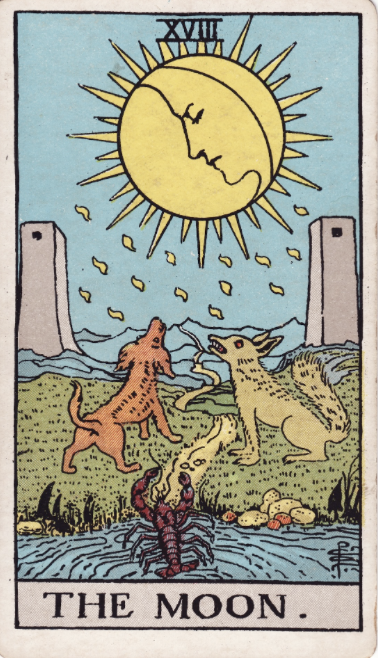The Moon – Illusion, Ancestry, and the Subconscious Path
The Moon, numbered XVIII in the Major Arcana, is one of the most enigmatic and multilayered cards in the Tarot. It illuminates the night with borrowed light, casting long shadows and revealing what the Sun cannot. It is the card of mystery, illusion, dreams, and the unseen forces that shape our psyche. The Moon doesn’t lie—but it does ask you to question what is real.
Symbolically, the card is rich with archetypal imagery: a dog and a wolf howl at the Moon, representing the tamed and wild aspects of our instincts. A crayfish emerges from the water, beginning its journey up a long and winding path between two towers. This is the pilgrimage of the subconscious, a descent into the underworld of the Self.
The Moon reveals that truth is not always linear. It is hidden in symbols, sensations, and deep emotional tides. This card appears when we are navigating liminality—transitions, shadows, and psychic revelations. It asks us to surrender to what we feel even if we cannot yet articulate it.
Personal Reflection: Past Lives, Ancestral Memory, and Shamanic Dreams
Whenever The Moon appears in a reading, I immediately feel the pulse of ancestral memory, the drumbeat of past lives echoing through time. I often connect this card with the Past Lives card in the Osho Zen Tarot, which replaces The Moon with a depiction of our karmic storylines—spanning lifetimes, lineages, and the veils of time. That card, much like The Moon, reminds us that what we are experiencing is rarely just about this moment. It is a ripple from something older, deeper, unseen.
As a medium and a healer, I’ve spent years navigating other realms. I’ve found that so many of the patterns we carry—especially those that surface during Moon times—are not just from childhood or trauma. They come from the ancestors, from the energy we inherit epigenetically and spiritually. We carry their grief, their gifts, and their unresolved dreams. The Moon card is a sacred call to uncover and remember.
In my own life, lucid dreams have often been the Moon’s classroom. I’ve had dreams that delivered exact phrases someone would say to me the next day, dreams where I’ve met ancestors I had no conscious knowledge of, and dreams where I crossed the bridge into other lifetimes. In these moments, The Moon wasn’t a symbol—it was an experience.
This card is deeply shamanic in nature. It is the lunar vision quest. The call to descend into your inner forest and speak with your spirits, your fears, and your forgotten selves.
The Deep Symbolism of The Moon
The Moon card is layered with rich symbols that mirror the path of the mystic:
The Moon: Illuminates the landscape with reflected light, representing dreams, illusion, and intuition.
Dog and Wolf: These animals symbolize the domesticated and wild instincts within us, both howling at the same mystery.
Crayfish or Lobster: Emerging from the primordial waters of the unconscious, it represents the beginning of a psychic journey.
Winding Path: Symbolizes the unknown journey of spiritual awakening. It is not straight or clear—but it is divinely guided.
Twin Towers: Gateways between worlds, marking a liminal space between what was and what will be.
The Moon is astrologically tied to Pisces, the sign of mystics, empaths, and dreamers. It resonates with the Kabbalistic path of Qoph (ק)—the back of the head, the place where dreams are birthed and psychic intuition flows.
Carl Jung on The Moon Archetype
Carl Jung’s work on the subconscious, shadow, and the collective unconscious aligns beautifully with the meaning of The Moon. Jung believed that the dream world was a sacred space where the Self communicates through archetype, symbol, and sensation.
The Moon corresponds to what Jung called the Shadow—the hidden, repressed, or denied parts of ourselves that long to be integrated. This card is not just about mystery; it’s about revelation. But that revelation is not always logical—it comes through dreams, intuition, and emotion.
In Jungian psychology, The Moon also symbolizes the Anima—the feminine, feeling-toned inner life. The anima guides us into emotional depth, into the watery unknown where true transformation is possible. Jung said:
“Who looks outside, dreams; who looks inside, awakens.”
The Moon card is an invitation to do just that—to look within and wake up to the soul’s deeper story.
Conclusion: Trust the Path You Cannot See
The Moon is not a warning—it’s a whisper. A call to slow down, dream more deeply, and trust the unseen. It invites you to sit with the ancestors, to feel the rhythms of your blood and your bones, to remember that you are more than what you can prove.
So ask yourself:
What dream keeps returning?
What emotion are you avoiding?
What ancestral thread is tugging at your heart?
The Moon tells us that wisdom is not always logical. Sometimes, it comes in the middle of the night, wrapped in metaphor and moonlight. Trust it. Follow it. Let it guide you across the bridge to the deeper Self.
In the Moonlight, everything looks different—and that’s the point.

